After
dinner, we walked around the small town of Ortahisar. We noticed that
there were a lot of men out - and only men. They were drinking tea,
smoking, playing backgammon and a mahjong-type game, and many of them
were getting their hair cut and/or a shave. (There seemed to be more
barbers (and pharmacists) in the town than anything else). Clearly
this is the norm for evenings. We decided to buy one of the Cappadocia
souvenir books from a local shop (cheaper than at the hotel and we'd
rather give them the money), and the owner insisted that we come into
the shop (he invited us for tea, but we were full from the
hotel buffet) where he presented Elyse with a beaded bracelet. It's a
nice memory/reminder and she wore it the remainder of the trip.
Sitting in the courtyard of the hotel that evening (a beautiful night
with a full moon), we were struck with the number of languages we
heard, including Spanish, French, Russian, Hebrew, German, and 'Strine
(a strange form of English spoken in Australia). Then there were the
very loud frogs (would have drowned out the Hillsdale frogs easily)....
The next morning, we were met by our guide and driver. We had considered renting a car and going around on our own, but realized that this would cost about the same and that we would probably learn a lot more (and be a lot less stressed). We are so glad that we did. The guide was superb; we learned a lot and enjoyed his stories and company. It was also nice not to have to worry about navigating. We had a full day with them (9 a.m. - 6 p.m.) and saw a huge range of sights.
Our first stop was the Goreme Open-Air museum. This area encompasses a good number of the cave-churches, as well as monasteries, chapels and rectories. (It is estimated that there are about 600 rock-cut churches in Cappadocia, so "good number" is relative; let's say a good number of the elaborate churches that are open to tourists.) We visited about a half-dozen of the churches and each was impressive. Many of these churches included domes, vaults, apses, columns and niches that did not, obviously, serve as architectural support. They were beautifully carved though. However, it was the paintings that really took our breath away. There were layers of paintings in some showing their use by many over the centuries. We could see the geometric designs done during the iconoclastic period of the 8th century when human figures were forbidden. The later paintings and frescoes (up to the 14th century) were images of the life of Christ and biblical stories. Here are some samples of what we saw. None of the photos do the places justice (no flash photography is allowed), but it will give you a taste of what we saw. You might notice that in many, the eyes have been damaged. There are many theories about who did this: ancient Greeks (relic-gathering and/or using in potions), ancient Muslims (human forms are not allowed in art; destroying the eyes was a way of "killing" the subject) or maybe even in modern times after the exchange of populations between Greece and Turkey in 1924 (as an act against the Christian Greeks who had been sent out of Turkey). Despite the years of erosion, vandalism and destruction, there was still plenty to keep us in awe! Remember, these are all carved out of caves.
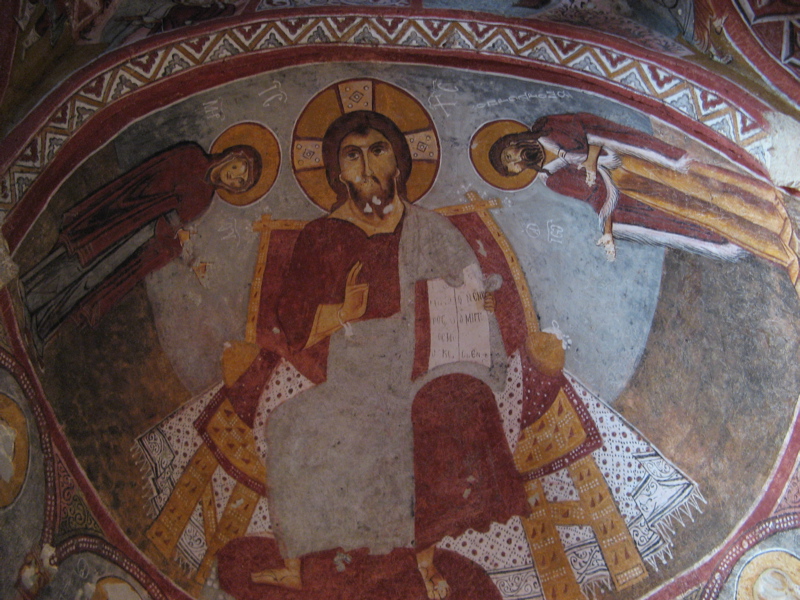
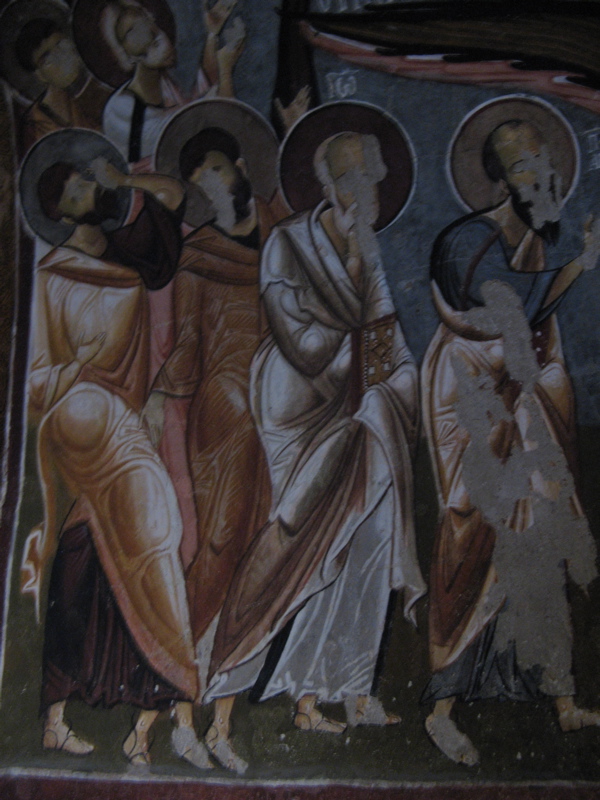
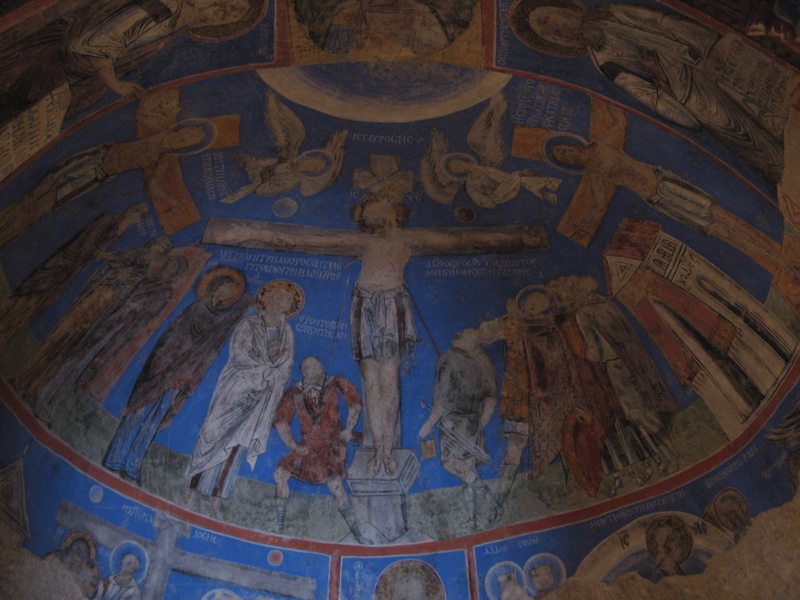
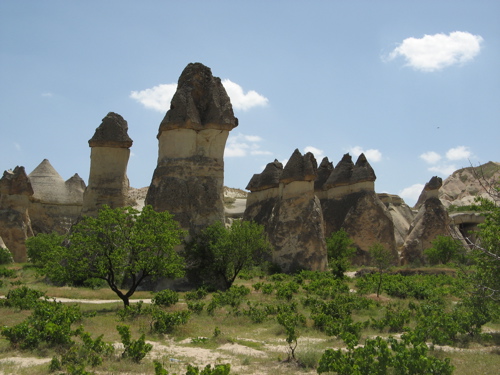

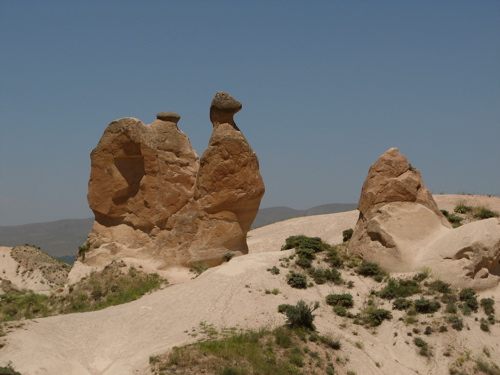
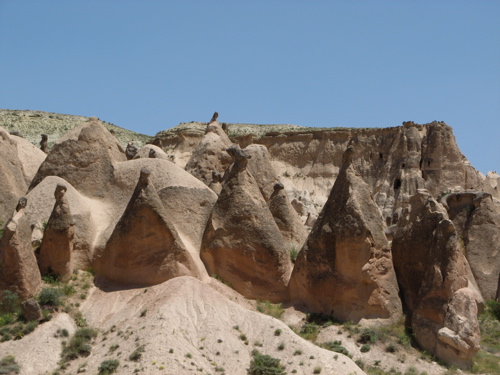
We had lunch in Avanos, on a rooftop terrace of an old pasha's mansion that has been converted into a restaurant. It was very hot, so we tried to eat a bit less than usual by Turkish standards, but that was still more than we needed. It was all delicious. We decided to skip tasting the Cappadocian wine with lunch so that we could stay awake in the afternoon. But we didn't skip the dessert: dried figs slightly reconstituted with a sweet liquid and stuffed with walnuts. Yummy combination. The town of Avanos is known for its craftwork: pottery and tiles (5,000-year tradition in the area), jewelry, and carpet weaving. So after lunch we were taken to Firça, a 250-year old family pottery "factory". The pottery center is in a huge cave (4500 square meters) - that was a cool relief from the heat. One of the family members took us on a tour (complete with a glass of tea, of course): first we saw a potter create a bowl on an electric wheel and then another potter create a covered bowl on a kick wheel. They offered to let us try to make something - and Gerald was game to - but then we got side-tracked and that didn't happen. They showed us the kiln used to "bake" the clay, and then took us to the artists' section. There were two people who were each painting the black outlines of designs on large serving platters. One was painting an intricate geometric design, while the other was painting stylized fish. It was amazing to see them create these stunning, detailed designs free-hand with such precision. The next step in the process are the painters, who apply the variety of colors that are such standards in this area - deep blues and greens and a rusty red. The final step was the sales pitch, of course. The room we ended up in had (not surprisingly) the "museum-quality" pieces, then there was the room with the excellent quality pieces and, finally, the ones for daily use. The museum-quality room really did feel like a museum. There were plates and bowls of different sizes, shapes and colors; traditional circle shaped (so that it could be draped over one's shoulder for pouring) wine jugs (see them on the back wall in the photo below); and lots of painted tiles. It's times like these that we wish we were infinitely wealthy. We fell in love with this tulip tile, but as it was about $1,000, we thought we'd take a photo instead.
The next morning, we were met by our guide and driver. We had considered renting a car and going around on our own, but realized that this would cost about the same and that we would probably learn a lot more (and be a lot less stressed). We are so glad that we did. The guide was superb; we learned a lot and enjoyed his stories and company. It was also nice not to have to worry about navigating. We had a full day with them (9 a.m. - 6 p.m.) and saw a huge range of sights.
Our first stop was the Goreme Open-Air museum. This area encompasses a good number of the cave-churches, as well as monasteries, chapels and rectories. (It is estimated that there are about 600 rock-cut churches in Cappadocia, so "good number" is relative; let's say a good number of the elaborate churches that are open to tourists.) We visited about a half-dozen of the churches and each was impressive. Many of these churches included domes, vaults, apses, columns and niches that did not, obviously, serve as architectural support. They were beautifully carved though. However, it was the paintings that really took our breath away. There were layers of paintings in some showing their use by many over the centuries. We could see the geometric designs done during the iconoclastic period of the 8th century when human figures were forbidden. The later paintings and frescoes (up to the 14th century) were images of the life of Christ and biblical stories. Here are some samples of what we saw. None of the photos do the places justice (no flash photography is allowed), but it will give you a taste of what we saw. You might notice that in many, the eyes have been damaged. There are many theories about who did this: ancient Greeks (relic-gathering and/or using in potions), ancient Muslims (human forms are not allowed in art; destroying the eyes was a way of "killing" the subject) or maybe even in modern times after the exchange of populations between Greece and Turkey in 1924 (as an act against the Christian Greeks who had been sent out of Turkey). Despite the years of erosion, vandalism and destruction, there was still plenty to keep us in awe! Remember, these are all carved out of caves.
One
of the other major draws in Cappadocia are the strange-shaped rocks
that have formed over the years. The area was formed by volcanic
activity and the land was covered with volcanic ash (tufa) that was
covered with basalt. The basalt doesn't erode as quickly and
determines the shape of a column of tufa based on how big a piece of
basalt is on top. Our next stop - the Pasabag Valley - showed this
clearly with the "fairy chimneys" pictured below.
Nearby
Devrent Valley has different formations, including Camel Rock (guess
which one!). It was fun to come up with "names" for some of the other
ones - like Napoleon's Hat and Baseball Glove. Sort of like looking at
clouds. Or not. We would have loved to have had the time to hike
through one of the valleys, but it was time for lunch so we had to move
on.
We had lunch in Avanos, on a rooftop terrace of an old pasha's mansion that has been converted into a restaurant. It was very hot, so we tried to eat a bit less than usual by Turkish standards, but that was still more than we needed. It was all delicious. We decided to skip tasting the Cappadocian wine with lunch so that we could stay awake in the afternoon. But we didn't skip the dessert: dried figs slightly reconstituted with a sweet liquid and stuffed with walnuts. Yummy combination. The town of Avanos is known for its craftwork: pottery and tiles (5,000-year tradition in the area), jewelry, and carpet weaving. So after lunch we were taken to Firça, a 250-year old family pottery "factory". The pottery center is in a huge cave (4500 square meters) - that was a cool relief from the heat. One of the family members took us on a tour (complete with a glass of tea, of course): first we saw a potter create a bowl on an electric wheel and then another potter create a covered bowl on a kick wheel. They offered to let us try to make something - and Gerald was game to - but then we got side-tracked and that didn't happen. They showed us the kiln used to "bake" the clay, and then took us to the artists' section. There were two people who were each painting the black outlines of designs on large serving platters. One was painting an intricate geometric design, while the other was painting stylized fish. It was amazing to see them create these stunning, detailed designs free-hand with such precision. The next step in the process are the painters, who apply the variety of colors that are such standards in this area - deep blues and greens and a rusty red. The final step was the sales pitch, of course. The room we ended up in had (not surprisingly) the "museum-quality" pieces, then there was the room with the excellent quality pieces and, finally, the ones for daily use. The museum-quality room really did feel like a museum. There were plates and bowls of different sizes, shapes and colors; traditional circle shaped (so that it could be draped over one's shoulder for pouring) wine jugs (see them on the back wall in the photo below); and lots of painted tiles. It's times like these that we wish we were infinitely wealthy. We fell in love with this tulip tile, but as it was about $1,000, we thought we'd take a photo instead.